Grammar_1_名词
高中英语Unit1TheworldofoursensesSectionⅢGrammar——名词性从句(Ⅰ)教案(含解析)牛津译林版必修3

Section ⅢGrammar——名词性从句(Ⅰ)名词性从句相当于名词,可分别作主句的主语、表语、宾语和同位语。
因此,名词性从句分为主语从句、表语从句、宾语从句和同位语从句,都不能用逗号与主句分开。
When we will start is not clear.(主语从句)我们何时动身还不清楚。
Mrs.Black won't believe that her son has become a thief.(宾语从句)布莱克夫人不相信她的儿子成了一个小偷。
My idea is that we should do it right now.(表语从句)我的意思是我们现在就开始做这件事。
I had no idea that you were her friend.(同位语从句)我不知道你是她的朋友。
一、引导名词性从句的连接词二、主语从句1.主语从句是在复合句中充当主语的从句,通常放在主句谓语动词之前或由形式主语it代替,而本身放在句子末尾。
主语从句通常由连词that和whether、连接代词或连接副词引导。
2.that在句中无词义,只起连接作用,在口语和非正式文体中可以省略,但that从句位于句首时,连词that不能省略。
3.连接代词和连接副词在句中既保留自己的疑问含义又起连接作用,在从句中充当成分。
That the football match will be put off is certain now.足球赛将会推迟一事现在已经确定。
Whether he will come or not is still a question.他是否会来仍然是个问题。
Whoever breaks this law deserves a fine.违反该法者应予以罚款。
When the plane is to take off has not been announced.飞机何时起飞还没有宣布。
It is known to all that light travels in straight lines.众所周知,光沿直线传播。
语法基础知识Grammar
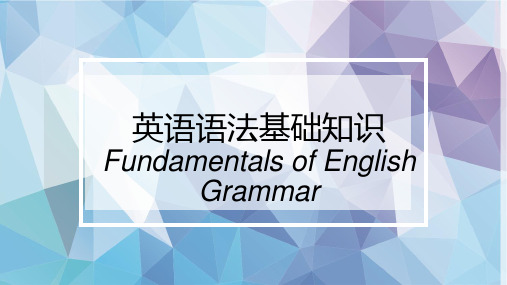
Taking a walk after supper is his habit. (动名短主)晚饭后散步是他的习惯。 Whether he will come or not remains to be seen. (主从)他是否来还要等等看。 It is true that he went there. (it = that-从句)他去了那里是真的。 It is wrong to tell a lie. (it = 不定式)撒谎是错误的。 It is not worth while your going there. (it = 动名短)你到那里去值不得。
短语或词组(phrase):有一个以上的词构成的语法单位
常见的短语有:
1) 名词短语:John and Mary, the suggestion of yours, the doctor’s, etc.
2) 数词短语:two of us, three times three, the first of October, etc. 3) 动词不定式短语:hope to do、agree to do 4)动词-ing短语(动名词短语或现在分词短语) keep doing、feel like doing
短语或词组(phrase):有一个以上的词构成的语法单位
常见的短语有:
5)介词短语: at first、in charge of 6)过去分词短语:seen from、accepted by 7)副词短语:out of the window, south of Beijing, etc. 8) 形容词短语:long and tedious, worthy of careful consideration, indicative of, etc.
七年级上册英语grammarfocus原文
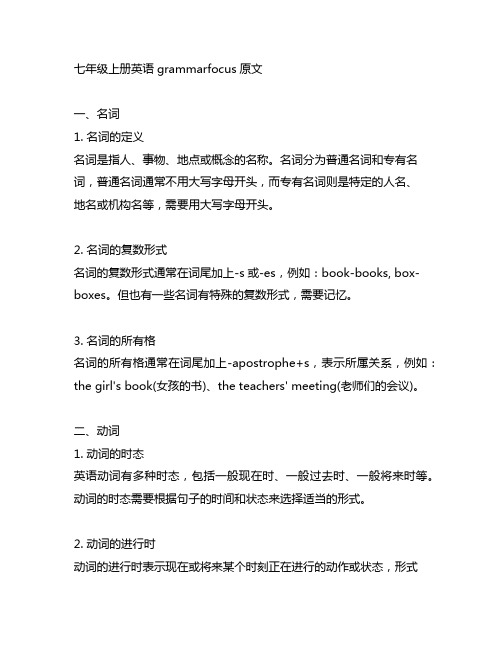
七年级上册英语grammarfocus原文一、名词1. 名词的定义名词是指人、事物、地点或概念的名称。
名词分为普通名词和专有名词,普通名词通常不用大写字母开头,而专有名词则是特定的人名、地名或机构名等,需要用大写字母开头。
2. 名词的复数形式名词的复数形式通常在词尾加上-s或-es,例如:book-books, box-boxes。
但也有一些名词有特殊的复数形式,需要记忆。
3. 名词的所有格名词的所有格通常在词尾加上-apostrophe+s,表示所属关系,例如:the girl's book(女孩的书)、the teachers' meeting(老师们的会议)。
二、动词1. 动词的时态英语动词有多种时态,包括一般现在时、一般过去时、一般将来时等。
动词的时态需要根据句子的时间和状态来选择适当的形式。
2. 动词的进行时动词的进行时表示现在或将来某个时刻正在进行的动作或状态,形式为助动词be加动词的现在分词形式,例如:I am reading(我正在阅读)、He is playing football(他在踢足球)。
3. 动词的完成时动词的完成时表示某个动作在过去的某个时间完成,形式为助动词have/has加动词的过去分词形式,例如:She has finished her homework(她已经完成了她的作业)。
三、形容词与副词1. 形容词的用法形容词用来修饰名词或代词,表示人或事物的性质、特征或状态,通常直接放在名词或代词之前。
2. 形容词的比较级和最高级形容词的比较级用来表示两者之间的比较程度,最高级则用来表示三者或三者以上的比较,形式为加-er和-est,或在前面加more和most。
3. 副词的用法副词用来修饰动词、形容词或其他副词,表示时间、地点、方式、原因等,通常放在所修饰的词之前或之后。
四、代词1. 人称代词人称代词用来代替人或物,分为主格、宾格和所有格三种形式,例如:I(me, my, mine)、you(you, your, yours)、he/she/it(him/her/it,his/her/its)、we(us, our, ours)、they(them, their, theirs)。
Grammar英语语法
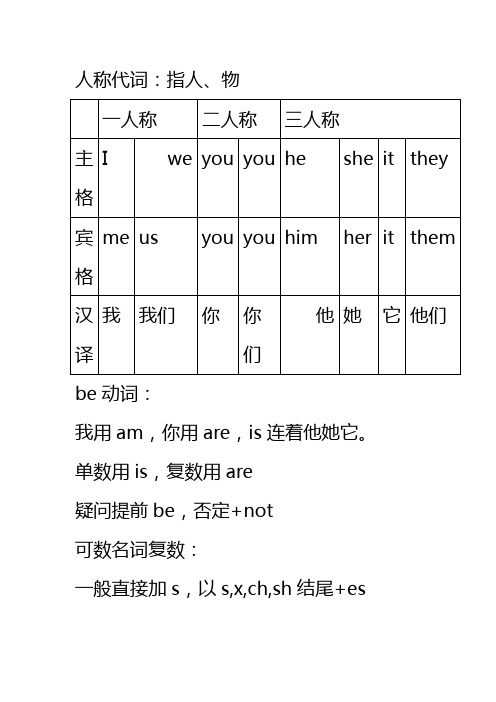
人称代词:指人、物be动词:我用am,你用are,is连着他她它。
单数用is,复数用are疑问提前be,否定+not可数名词复数:一般直接加s,以s,x,ch,sh结尾+eso结尾,有生命+es,无生命+s辅音+y结尾,y变i+esf,fe结尾,f,fe变v+esf,fe结尾,直接加s:giraffe,roof,handkerchief,scarf,golf可数名词有单复数,单数用a/an修饰,不可数名词无复数,常与a+量词+of+u.n. 两者都可用some修饰指示代词:this(这个),that(那个),these (这些),those(那些)所有格:表人:sb+’s表物:of(前后倒置)there be:有地点介词:里面in,上面on,over,under 上下方;between…and两者间,among用于3者间,紧挨next to,附近near,before 后面,in front of在外部前方,in the front of空间内部前方来自from,朝前to,里面穿过是through,表面穿过across,到里面into,到上面onto 一般现在时:表示经常反复、现在状态、客观真理助动词:do,does否定分别don’t,doesn’t 动词单三:一般+s,以s,x,ch,sh,o结尾,词尾+es,辅音+y结尾,y变i+es,have单三是has 一般疑问句把be、情态动词、助动词提前,谓语动词还原特殊疑问句=特殊疑问词+一般疑问句how many提问可数名词复数how much提问不可数名词年月季节前用in,日期前面可不行,具体几号要用on,上午下午又是in,具体某天上下午,要用on来不用inat用法真不少,正午午夜到黎明频度副词:always(100%),usually(90%),often(80%),sometimes(40%),seldom(30%) never(0%)现在进行时:表现在正在进行的动作结构:be+doing现在分词变化规则:一般直接+ing不发音e结尾,去e+ing重读闭音节结尾,双写词尾辅音字母+ing ie结尾,ie变y+ing形容词:系动词后,名词前;译为:…的方式副词:用在动词后,译为:…地形容词变副词规则:一般直接+ly,个别e结尾去e+ly,y结尾,y变i+ly情态动词:can,should,shall,would,could+v原;否定+not,疑问直接提前have to,would like to,+v原;否定前+don’t 疑问前+do一般过去时:表过去发生的事动词过去式变化规则:一般直接+ed,e结尾+d,辅音字母+y结尾,y变i+ed重读闭音节,双写辅音字母+ed过去时中,助动词用did,be的过去式为was(am,is),were(are)其他结构和现在时相同祈使句:表命令、警告、指示、建议肯定:v原+其他否定:don’t+v原+其他and表并列,多个成分用and连接,在最后两个成分之间,其余用逗号隔开or表选择,用法与and相同but表转折,连接相反意义的词some用于肯定句中,接可数名词复数或不可数名词any用于否定句和疑问句中,用法和some一样表委婉语气时,some在疑问句中不变any 形容词、副词的比较级和最高级变化规则:一般+er/est,e结尾,+r/st重读闭音节结尾,双写辅音字母+er/est 辅音字母+y结尾,y变i+er/est多音节词在前面+more/most一般将来时:表将要发生,或对未来打算三种表达方式:will/shall+v原be going to+v原be doing表将来过去进行时:表过去某一时间正在进行的动作构成:was/were+doing现在完成时:表发生在过去已经完成的动作对现在造成的影响或后果结构:have/has+done一般动词过去分词与过去式变化相同一般疑问句把have/has提前其他不变,否定在have/has后+nothave been to曾经去过某地(已回)have gone to曾经去过某地(未回)already(已经)用在have/has和过去分词之间,用在句末表强调,常用于肯定句中yet用法和汉译与already相同,常用于否定或疑问句中since+时间点,译为自从…以来for+段时间,现在完成进行时:表开始于过去,现在仍进行或刚刚结束的动作现在完成进行时构成:have/has been doing 时间状语从句:1.when引导:表时间段或时间点,译为当…时候用法:主从同现/过,或主将从现2.while引导:表主、从动作同时进行用法:主从同现/过3.as soon as引导:译为一…就…4.not…until…引导:译为直到…才…条件状语从句:1.if引导:译为如果用法:主将从现2.unless引导:译为如果不/除非用法和if相同unless引导否定从句,与if…not不可互换,否则意思相反结果状语从句:so…that…引导:译为如此…以致于…原因状语从句:because引导:译为因为because和so不能连用because引导原因状语从句,从句一般在主句之后让步状语从句:although/though引导:译为虽然although/though不能和but/however连用直接引语:直接用别人原话,用引号标出间接引语:用自己的话转述别人的话,不用引号直接引语变间接引语要把现在时变为过去时,一人称变三人称,三人称一般不变附加疑问句:在陈述句之后,表对陈述内容提出质疑或通过反问以确定陈述句的一种疑问句构成:前肯后否,前否后肯陈述部分是I’m,附加部分用aren’t I答语用yes,肯定陈述部分;no否定陈述部分陈述句带有否定词,附加用肯定不定代词(表人)在正式语体中用he,非正式语体中用they不定代词(表物)用it。
英语语法 Basic GrammarⅠ词性
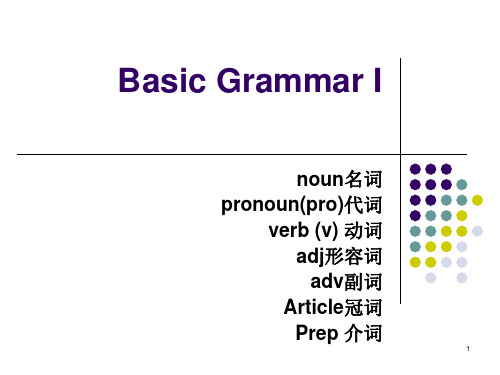
Quietly V
11
Find out the adv副词 II
He runs fast. fast She smiles happily. Happily
He shouts angrily. angrily
He hits it heavily. heavily
12
Find out the prep 介词
15
11. Don’t move the chair. ___它的 legs are broken. 12. Lily is ____ 我们的tutors. She teaches ___我们 English. ___我们 like ___她 so much. 13. I am right. _____你们 are wrong. 14. Where are ___你 from? I don’t know ___你。 15. ____他们 are on B level. We don’t take the same classes with _____他们。 _____他们的 classes are harder than ___我们的 classes.
and on
in
under
13
Find out the article冠词
a the
an
our
14
Exercise(pro)
代词练习 1. ___ 我don’t like ___ 我的 coat. 2. A: Where is the toilet? B: Follow ___跟我来. 3. ____你 don’t understand ____我。 4. I don’t know ____你。 5. A: Is this _______你的 book? B:No, it’s ____她的book. 6. Who is ____他? 7. Do you like _____他? 8. That’s _____他的 pen. 9. ____她is my girl friend. I love ____她very much. This is ____她的photo. 10. _____ 它is my pen. Give ___它 to me.
(完整版)英语重音规律表(54常见重音词汇)

(完整版)英语重音规律表(54常见重音词汇)以下是54个常见英语重音词汇及其重音规律:1. Grammar (名词): 重音在第一个音节上,即gra-mmar.Grammar (名词): 重音在第一个音节上,即gra-mmar.2. Accent (名词): 重音在第一个音节上,即ac-cent.Accent (名词): 重音在第一个音节上,即ac-cent.3. Record (动词): 重音在第二个音节上,即re-cord.Record (动词): 重音在第二个音节上,即re-cord.4. Produce (动词): 重音在第二个音节上,即pro-duce.Produce (动词): 重音在第二个音节上,即pro-duce.5. October (名词): 重音在第三个音节上,即oc-to-ber.October (名词): 重音在第三个音节上,即oc-to-ber.6. Eleven (数字): 重音在第二个音节上,即e-leven.Eleven (数字): 重音在第二个音节上,即e-leven.7. Holiday (名词): 重音在第一个音节上,即ho-li-day.Holiday (名词): 重音在第一个音节上,即ho-li-day.8. Family (名词): 重音在第二个音节上,即fa-mi-ly.Family (名词): 重音在第二个音节上,即fa-mi-ly.9. Silent (形容词): 重音在第一或第二个音节上,即si-lent.Silent (形容词): 重音在第一或第二个音节上,即si-lent.10. Machine (名词): 重音在第二个音节上,即ma-chine.Machine (名词): 重音在第二个音节上,即ma-chine.依此类推,以下是其他重音词汇及其重音规律:11. Table (名词): 重音在第一个音节上,即ta-ble.Table (名词): 重音在第一个音节上,即ta-ble.12. Minimum (名词): 重音在第二个音节上,即mi-ni-mum.Minimum (名词): 重音在第二个音节上,即mi-ni-mum.13. Animal (名词): 重音在第三个音节上,即a-ni-mal.Animal (名词): 重音在第三个音节上,即a-ni-mal.14. Before (介词): 重音在第一个音节上,即be-fore.Before (介词): 重音在第一个音节上,即be-fore.继续如此,以下是其他重音词汇及其重音规律:.....54. Environment (名词): 重音在第三个音节上,即en-vi-ron-ment.Environment (名词): 重音在第三个音节上,即en-vi-ron-ment.请注意,以上只是一部分常见英语重音词汇,更多的重音规律需要逐一学习和掌握。
grammar语法

不规则变化
4)以s结尾,仍为单数的名词,如: a. maths,politics,physics等学科名词,为不可数名词,是单 数。 b. news 是不可数名词。 c. the United States,the United Nations 应视为单数。 The United Nations was organized in 1945. 联合国是 1945年组建起来的。 d. 以复数形式出现的书名,剧名,报纸,杂志名,也可视为单数。 "The Arabian Nights" is a very interesting story-book. <<一千零一夜>>是一本非常有趣的故事书。
1.3不可数名词量的变化
物质名词 a. 当物质名词转化为个体名词时。 比较: Cake is a kind of food. 蛋糕是一种食物。 (不可数) These cakes are sweet. 这些蛋糕很好吃。 (可数) b. 当物质名词表示该物质的种类时,名词可数。 This factory produces steel. (不可数) We need various steels. (可数) c. 当物质名词表示份数时,可数。 Our country is famous for tea. 我国因茶叶而闻名。 Two teas, please. 请来两杯茶。
3) 有些原有s结尾的名词,作定语时,s保留。 如:goods train (货车) arms produce 武器生产 customs papers 海关文件 clothes brush衣刷 4) 数词+名词作定语时,这个名词一般保留单数形式。 如:two-dozen eggs 两打/(二十四个鸡蛋) a ten-mile walk 十里路 two-hundred trees 两百棵树 a five-year plan 一个五年计划
英语语法第一课
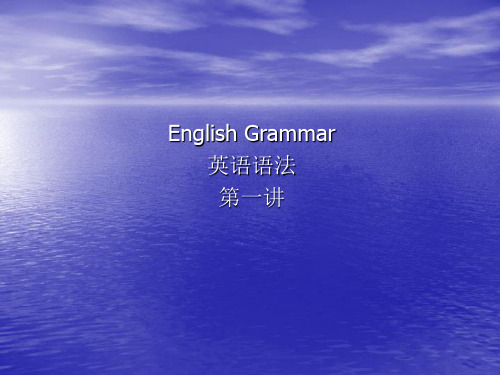
语的动作和状态的。
• 3.表语(predicative)它是放在连系动词之
后表示主语的身份或特征的。表语也就是 主语补语。补语(complement)分为主语补 语和宾语补语。
• 4.宾语(object)它是表示及物动词动作的
对象的。
• 5.定语(attribute)它是限定或修饰名词或
English Grammar 英语语法 第一讲
1.语法是什么? (What is grammar? )
• 语法是语言的组织规律, 它赋予语言以结构
系统。(the entire system of a language, including its syntax, morphology, semantics, and phonology)
• 7.冠词(article, 缩写为art.) 说明名词所指的
人或物的词。An article is a name for the (definite article) and a, an (indefinite
article).
• 8.介词(preposition,缩写为prep.) 表示名词
• 4.他是我的顶头上司。 • He is above me. • 5.微积分对我来说太难了。 • Calculus was always beyond me. • 6.你打这个电话就能找到我。 • You can reach me at this phone number.
4. How does that song go?
• 具体地讲, 主要有下列六种句子成分。
• 1. 主语(subject)它是句子所要说明的人
或事物, 是一句的主体。The subject is the part of the sentence that names whom or
大学英语语法名词总结grammar terms

Grammar terms1.Inflectional Affix 屈折词缀example:-es,-s,-ed,-d,-er,-est2.Derivational Affix派生词缀example:prefix:anti-,co-,un-;suffix:-ion,-ness3.Derivative派生词example:unfair,nonsmokerpound word复合词n. + n. workshop, bookshelf, lifesaver, color-filmpron. + n. she-wolf, he-bear, he-mann. + v. sunrise, sunset, shoplift, power-cutv. + n. scarecrow, telltale, breakfast, turncoata. + n. greenhouse, red-tape, bluebooka. +n. + ed. smooth-tongued, cold-blooded, narrow-minded, high-nosedn. + v. + ed. heart-broken, weather-beaten, home-made, heartfeltn. + v. + ing. peace-keeping, law-abiding, time-saving, truth-telling, fact-findingn. + a. blood-thirsty, ice-free, snow-white, homesicka. + n. high-grade, first-class, long-range, new-type, second-handa. + a. bloody-red, bittersweet, dead-alive, white-hotv. + a. test-wise, failsafe, diehard, talk-bigprep. + n. indoor, overhead, aboveboard, onlinehyphen conj. out-of-door, life-and-death, wait-and-seeadv. + v. to overtake, to uplift, to uproot, to underline, to downplay, to uploadn. + n. to brainstorm, to streamline, to dog-ear, to windsurf, to showcasen. + v. to air-drop, to eavesdrop, to breastfeed, to nose-dive, to masterminda. + v. to safeguard, to whitewash, to blindfold5.Closed class封闭词类介词preposition in,of,on,without代词pronoun you,he,one,which限定词Determiner a,the,this,some连词conjunction and,or,but,because助动词Auxiliary do,can,may,must,willDeterminer限定词definite article,indefinite article,zero article, a,the,/possessive determiner物主限定词my,your,hisgenitive noun名词属格John’s,Bob’sdemonstrative determiner 指示限定词this,thatRelative determiner 关系限定词whose,whichInterrogative determiner 疑问限定词what,whose,whichIndefinite determiner不定限定词no,some,any,everyCardinal numeral基数词&ordinal numeral序数词Multiplicative numeral倍数词& fractional分数词Quantifier量词 a lot of,a great number of6.Open class 开放词类noun,adjective,adverb,main verb7.介于封闭与开放cardinal numbers基数词,ordinal numeral序数词;interjection 感叹词8.Phrase词组Noun phrase(det.)限定词+ (modifier) + Noun + (modifier)a lazy boy still asleep ;the earthquake of Richter magnitude 8Verb phrase Simple VP: Main Verb + (modifier)Complex VP: Auxiliary + Main Verb + (mod.)Example: to pull one’s leg 开某人玩笑;to pull up one’s socks 鼓起勇气Adverb phrase(modifier) + Adverb + (modifier)Example : far away from downtown Chengdu.Adjective phrase(modifier) + Adjective + (compliment)Example: extremely easy; too boring to be enjoyable.Prepositional phrase (modifier) + preposition + complimentExample: easy for operation;powerful in function9.Clause分句 A.independent clause独立分句/Dependent(subordinate) clause 从属分句B.Simple clause/complex clause(有其他主谓成分)C.Main clause 主句/subordinate clause分句D.Finite clause/non-finite clause(以非限定动词词组作谓语动词)10.Sentence句子 A. Full sentence/minor sentenceB.Simple sentencepound sentence并列句example:I don’t agree with you, butI’ll give my life to defend your right of saying it.plex sentence复杂句example:What the teachers told us inschool is not the same as what it is in the society.pound-complex sentence复杂并列句example:We don’t carewhat your say, but what you do.11.Noun Proper noun专用名词Common noun普通名词individual noun个体名词<C.N>;collective noun集体名词<C.N/U.N>;material noun物质名词<U.N>;abstract noun抽象名词<U.N>.12.Pronoun代词 A. Personal pronoun人称代词I,me,youB.Possessive pronoun 物主代词his,mine,hersC.Reflexive pronoun反身代词myself,yourself,ourselvesD.Reciprocal pronoun相互代词each other,one anotherE.Demonstrative pronoun 指示代词this,that,those,theseF.Interrogative pronoun 疑问代词what,who,whoseG.Relative pronoun关系代词who (whom) / that ,which / thatH.Infinitive pronoun不定代词Numeral&Quantifier much,many,lots ofCompound pronoun anything。
七年级英语译林版下册Unit1_Grammar教材知识详析
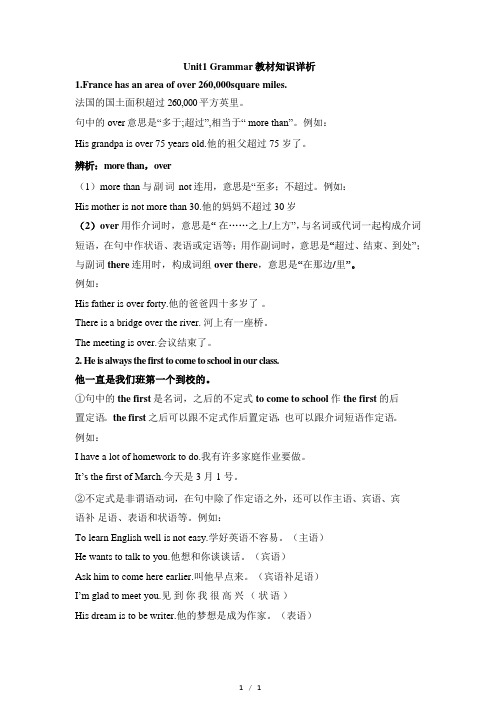
Unit1 Grammar教材知识详析1.France has an area of over 260,000square miles.法国的国土面积超过260,000平方英里。
句中的over意思是“多于;超过”,相当于“ more than”。
例如:His grandpa is over 75 years old.他的祖父超过 75 岁了。
辨析:more than,over(1)more than与副词not连用,意思是“至多;不超过。
例如:His mother is not more than 30.他的妈妈不超过30岁(2)over用作介词时,意思是“在……之上/上方”,与名词或代词一起构成介词短语,在句中作状语、表语或定语等;用作副词时,意思是“超过、结束、到处”;与副词there连用时,构成词组over there,意思是“在那边/里”。
例如:His father is over forty.他的爸爸四十多岁了。
There is a bridge over the river. 河上有一座桥。
The meeting is over.会议结束了。
2. He is always the first to come to school in our class.他一直是我们班第一个到校的。
①句中的the first是名词,之后的不定式to come to school作the first的后置定语。
the first之后可以跟不定式作后置定语,也可以跟介词短语作定语。
例如:I have a lot of homework to do.我有许多家庭作业要做。
It’s the first of March.今天是 3 月 1 号。
②不定式是非谓语动词,在句中除了作定语之外,还可以作主语、宾语、宾语补足语、表语和状语等。
例如:To learn English well is not easy.学好英语不容易。
Chomsky TG grammar-1

content
Brief Introduction of Chomsky
Chomsky's Theory
Chomsky’s Philosophy of Language
Development of TG Grammar
All these suggest that although babies are not born knowing a language (as they are born being able to see), they are born with a predisposition (倾向/能力) to develop a language in much the same way as they are born with a predisposition to learn to walk. Like the ability to walk, the ability to speak and understand spoken language seems to be a natural human activity.
Syntactic Structures(句法结构) marked
the beginning of the Chomskyan revolution.
Brief Introduction of Chomsky
Chomsky made his influence felt more and more in such fields as linguiuistics, psychology and philosophy. Not long after, he accepted an offer to e a professsor of linguistics at Massachusetts Institute of Technology(MIT) , and has been working at this institution ever since.
语法单词grammar
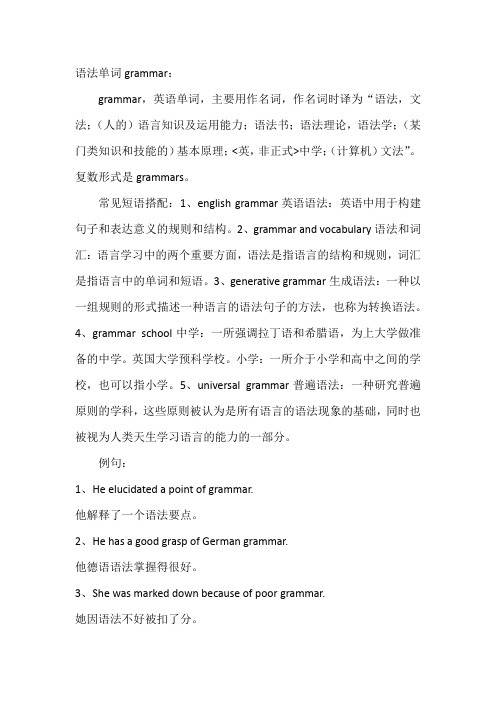
语法单词grammar:
grammar,英语单词,主要用作名词,作名词时译为“语法,文法;(人的)语言知识及运用能力;语法书;语法理论,语法学;(某门类知识和技能的)基本原理;<英,非正式>中学;(计算机)文法”。
复数形式是grammars。
常见短语搭配:1、english grammar英语语法:英语中用于构建句子和表达意义的规则和结构。
2、grammar and vocabulary语法和词汇:语言学习中的两个重要方面,语法是指语言的结构和规则,词汇是指语言中的单词和短语。
3、generative grammar生成语法:一种以一组规则的形式描述一种语言的语法句子的方法,也称为转换语法。
4、grammar school中学:一所强调拉丁语和希腊语,为上大学做准备的中学。
英国大学预科学校。
小学:一所介于小学和高中之间的学校,也可以指小学。
5、universal grammar普遍语法:一种研究普遍原则的学科,这些原则被认为是所有语言的语法现象的基础,同时也被视为人类天生学习语言的能力的一部分。
例句:
1、He elucidated a point of grammar.
他解释了一个语法要点。
2、He has a good grasp of German grammar.
他德语语法掌握得很好。
3、She was marked down because of poor grammar.
她因语法不好被扣了分。
高中英语Unit2 SectionⅡDiscoveringUsefulStructuresGrammar__名词形容词副词短语外研版必修第一册

Section ⅡDiscovering Useful Structures Grammar——名词、形容词、副词短语句法功能[新知导引]诵读下列例句并感知画线部分的共性1.The first week was a little confusing.2.The building is so big that I'm completely lost.3.My first French class was very confusing.4.I know that Chinese is a very difficult language.5.I tried to join the school football team, but the coach told me that I did n't play well enough.6.I understand quite well that you are anxious and feel terrible.[共性呈现]1.所有画线部分都是短语(词组)。
2.The first week, The building, My first French class属于名词短语,并作主语。
3.a little confusing, so big, completely lost, very confusing属于形容词短语,并且作表语;a very difficult language属于名词短语,作表语。
4.the school football team属于名词短语,作宾语。
5.so quickly与well enough属于副词短语,作状语。
[语法精释]一、名词短语(Noun Phrases)名词短语:指一个名词为中心构成的短语,在句中的功能相当于名词,可作主语、宾语、表语或宾语补足语。
常见名词短语的构成形式有:限定词+名词如:the girl限定词+形容词(短语)+名词如:a beautiful girl限定词+名词+介词短语如:a beautiful campus of my school限定词+描述性名词+名词如:my school life①The young lady over there is my English teacher.那边的那位年轻女士是我的英语老师。
Grammar

Ⅰ词类1.名词n. (noun [naun])指代人、物、事、时、地、情感、概念等实体或抽象事物的词。
专有名词:具体的人,事物,地点,团体或机构的专有名称。
如Beijing,China 专有名词如果是含有名词短语,则必须使用定冠词the。
如the Great Wall姓氏名如果采用复数形式,则表示该姓氏一家人。
如the Greens普通名词:某些人,某类事物,某种物质或抽象概念的名称,如book,sadness 可数名词cn. (countable noun)不可数名词un. (uncountable noun)2.动词v. (verb [və:b])表示动作或状态的词。
实义动词:词义完整,可以独立做谓语。
及物动词vt. (transitive verb)不及物动词vi. (intransitive verb)系动词:虽有词义,但不完整,不能独立做谓语,必须与表语一起构成谓语。
状态系动词“是”be表象系动词“看上去像、显得像是”look ,seem ,appear感官系动词“…起来”look ,feel ,smell ,taste ,sound持续系动词“保持、继续”keep ,remain ,continue ,last ,stay ,stand ,lie变化系动词“变得、变成”become ,turn ,grow ,go ,get ,come ,fall ,run终止系动词“被证实”prove ,turn out助动词:无词义,不能独立做谓语,只能与主要动词一起构成谓语。
be / do / have / shall / will情态动词:虽有词义,但不完整,不能独立做谓语,必须与动词原形构成谓语。
can / may / must / need / dare / ought to / shall / will情态动词表推测:must(一定)can/could(可能)may/might(也许)1.could,might并非can,may的过去式而表示可能性比can,may要小。
Grammar1
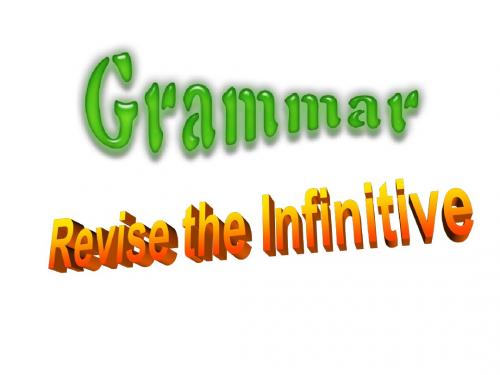
句型:think / consider / find /…+ it + adj. + to do
常见动词不定式作宾语的动词有:
agree, afford, appear, ask, attempt, care, choose, claim, dare, decide, demand, deserve, determine, expect, fail, get, hate, hesitate, hope, hurry, intend, learn, manage, offer, plan, prepare, pretend, promise, refuse, seem, tend, threaten, want, wish + to do
4. I don’t have time to sit around feeling sorry for myself. attribute 5. I am the only student in my class to take part in the competition. attribute 6. A big company has decided to buy it from me. object 7. My fellow students have begun to accept me for who I am. object
式做后置定语。
4. 如果不定式是不及物动词, 则后面需加
适当的介词。
Please pass me some paper to write ___. on
He is a good boy to get along well with
外研版英语必修一同步解析2.2

Section ⅡDiscovering Useful StructuresGrammar——名词、形容词、副词短语句法功能[新知导引]诵读下列例句并感知画线部分的共性1.The first week was a little confusing.2.The building is so big that I'm completely lost.3.My first French class was very confusing.4.I know that Chinese is a very difficult language.5.I tried to join the school football team, but the coach t old me that I didn't play well enough.6.I understand quite well that you are anxious and feel t errible.[共性呈现]1.所有画线部分都是短语(词组)。
2.The first week, The building, My first French class属于名词短语,并作主语。
3.a little confusing, so big, completely lost, very confusin g属于形容词短语,并且作表语;a very difficult language属于名词短语,作表语。
4.the school football team属于名词短语,作宾语。
5.so quickly与well enough属于副词短语,作状语。
[语法精释]一、名词短语(Noun Phrases)名词短语:指一个名词为中心构成的短语,在句中的功能相当于名词,可作主语、宾语、表语或宾语补足语。
常见名词短语的构成形式有:限定词+名词如:the girl限定词+形容词(短语)+名词如:a beautiful girl限定词+名词+介词短语如:a beautiful campus of my school限定词+描述性名词+名词如:my school life①The young lady over there is my English teacher.那边的那位年轻女士是我的英语老师。
- 1、下载文档前请自行甄别文档内容的完整性,平台不提供额外的编辑、内容补充、找答案等附加服务。
- 2、"仅部分预览"的文档,不可在线预览部分如存在完整性等问题,可反馈申请退款(可完整预览的文档不适用该条件!)。
- 3、如文档侵犯您的权益,请联系客服反馈,我们会尽快为您处理(人工客服工作时间:9:00-18:30)。
第1章名词1.1 名词概述名词表示人、事物、地点或抽象概念等的名称。
英语名词可分为普通名词和专有名词两大类。
普通名词包括:●抽象名词(abstract nouns):beauty, fear, courage, charity, joy, etc.●物质名词(material nouns):air, soap, beef, etc.●集合名词(collective nouns):family, group, team, swarm, crowd, flock, etc.●个体名词(individual nouns):table, man, dog, book, etc.专有名词包括人名、地名等,Tom, Mrs Smith, China, etc.1.2 名词的数1.2.1 什么是名词的数名词的数,指名词的单、复数形式。
英语名词有的有单数和复数之分,有的则没有。
下面介绍名词复数和复合名词复数的构成法。
1. 名词复数的构成法:●一般在名词词尾加-s。
dog-dogs, house-houses, gram-grams.●以-o或-s,-sh, -ch及-x结尾的名词加-es构成其复数形式。
tomato-tomatoes,kiss-kisses, watch-watches, box-boxes, bush-bushes.●有些以-o结尾,是外来语或缩写名词, 则加-s。
piano-pianos, dynamo-dynamos,photo-photos, kimono-kimonos.●有些以-o结尾的名词,其-o前是元音字母则加-s。
studio-studios, radio-radios.以-oo结尾的名词只加-s。
zoo-zoos。
●以-y结尾的名词,且-y前是一个辅音字母,则把-y去掉,加-ies。
baby-babies,university-universities, fly-flies, impurity-impurities.如果以-y结尾的名词,-y前是一个元音字母,则直接加-s。
boy-boys, donkey-donkeys.●以-f或-fe结尾的名词,一般将-f,-fe去掉,加-ves。
wife-wives, wolf-wolves,calf-calves.这类名词还有:life, knife, self, shelf, leaf, thief, sheaf, half等。
名词scarf,wharf, hoof, handkerchief的复数形式或加-s或去掉-f加-ves,即scarfs或scarves,wharfs或wharves, hoofs或hooves, handkerchiefs或handkerchieves。
也有些以-f或-fe结尾的名词只加-s。
cliff-cliffs, belief-beliefs, safe-safes, roof-roofs,chief-chiefs等。
●有些名词以改变元音构成其复数形式。
man-men, woman-women, goose-geese,foot-feet, mouse-mice, louse-lice, tooth-teeth等。
child的复数为children, ox的复数为oxen。
●有些表示生物的名词,其复数形式与单数相同。
fish-fish, sheep-sheep, deer-deer。
这类名词还有aircraft, means等。
2. 复合名词的复数形式:●一般在词尾加-s或-es。
take-off -- take-offs, grown-up -- grown-ups, armchair --armchairs, film-goer -- film-goers等。
●以man或woman为前缀构成的复合词,两部分都变成复数。
man doctor -- mendoctors, woman player -- women players等。
●主体名词在前,介词或副词在后的复合词只在主体词后加-s。
sister-in-law --sisters-in-law, looker-on --lookers-on, passer-by -- passers-by等。
●首字母缩略词(Initials),加-s以构成其复数。
VIPs (very important persons), MPs(Members of Parliament), UFOs (Unidentified Flying Objects)等。
●一些从希腊文或拉丁文转化而来的外来名词通常仍保持其原有的复数形式。
datum--data, crisis-crises, stimulus-stimuli, phenomenon-phenomena, basis-bases 等。
但也有些希腊,拉丁文外来语按英语的变化规则。
formula-formulas, campus-campuses, myth-myths等。
1.2.2 个体名词的数个体名词都是可数名词,都有单、复数形式。
个体名词的单数形式就是名词的原形,它的前面可用不定冠词a(n)和基数词one, a desk, one desk, a woman, one woman. 个体名词的复数形式有两种:一种是规则复数,即在名词原形之后加-s或-es构成,如books, bags, shoes, places, glasses, churches, leaves等;另一种是不规则复数,即不是以加词尾-s或-es构成复数,而是通过内部元音变换或其他方式构成复数,如tooth--teeth, man--men, mouse--mice, child--children, ox--oxen等。
1.2.3 集体名词的数集体名词有的能计数,有的不能计数,用法比较复杂。
比如有些集体名词本身没有复数形式,如果要计数,就得使用在语义上与之对应的个体名词。
集体名词个体名词●poetry poem●machinery machine●clothing garment, coat, etc.●furniture table, chair, etc.●cutlery knife●equipment tool●weaponry gun, pistol, ect.●foliage leaf●correspondence(信件) letter●luggage trunk, bag, etc.●police policeman●clergy clergyman但也有一些集体名词本身可用于个体意义,从而有单、复数形式,如team, a team, three teams; committee, a committee, several committees; family, a family, two families等。
1.2.4 物质名词的数有些名词既可作物质名词,也要作个体名词,前者不可数,后者可数。
这就要看这些名词用于何种意义。
例如rubber作“橡胶”解是不可数名词,因而无复数形式,如果用了复数,则语义改变,作“胶鞋”解;stone作“石料”解是不可数名词, 而作“一块块的石头”解则是可数名词;egg作“蛋渍”、“ 蛋白”解是不可数名词,而作“一个个的蛋”解则是可数名词;lamb作“羔羊肉”解是不可数名词,而作“羔羊”解则是可数名词;onion作“洋葱味”解是不可数名词,而作“洋葱头”解则是可数名词。
1.2.5 抽象名词的数抽象名词大多是不可数的,不能计数,因而没有单、复数之分。
Honesty is the best policy.Knowledge is strength.但也有一些抽象名词是可数的,如victory, a victory, two victories; conference, a conference, several conferences。
还有一些抽象名词可以复数形式出现,但不能计数。
例如difficulty, difficulties; opinion, opinions。
还有一些抽象名词有复数与非复数两种形式,但表示不同的意义。
以experience一词为例:当experience作“经验”解时,它没有复数,但作“经历”解时,两种形式均可。
The salesman met once a week to exchange experience(经验)。
Please tell us about your experiences(经历)in Africa.有些抽象名词表示抽象概念是不可数名词,而表示具体事物则是可数名词。
例如relation 作“关系”解是不可数名词,而作“亲戚”解则是可数名词;Youth作“青春”、“青年”(集合体)解是不可数名词,而作“男青年”解则是可数名词;worry作“忧愁”、“烦恼”解是不可数名词,而作“烦恼事”解则是可数名词。
有些抽象名词本身没有复数形式,如果要计数,就得用在语义上与之对应的个体名词。
抽象名词个体名词●laughter laugh●work job●correspondence(通信)letter, note, ect.●photography photo●permission permit●music song●fun joy●homework exercise英语中还有少数几个名词,如family, room, mouth, ear,等,似乎只能是可数名词,但实际上这类名词在某些搭配中也可表示抽象概念,从而成为不可数名词,例如to have too much family (=too heavy family burden), to have too much winter (= a too long spell of cold weather); to have too much mouth (= to talk too much), to have too little ear (= tobe not inclined to listen to others), to have room for (=to have a need for), to feel the patriot rise... (=to feel the patriotic feelings rise...)等。
英语中还有一些名词(大多是指人的名词),通常作可数名词,但在特殊的搭配中表示人的特质等抽象意义时便成了不可数名词。
例如fool本属可数名词,但在to be fool enough (=to be foolish enough), more of a fool (=more foolish), as much of a fool as (=as foolish as), too much of a fool (too foolish) 等搭配中,便表示抽象意义,成为不可数名词。
